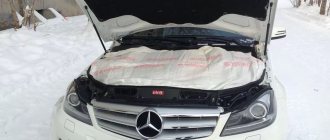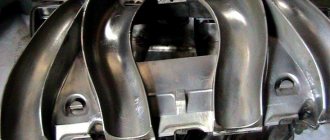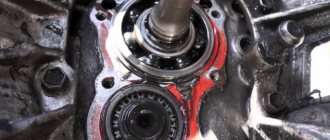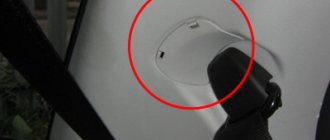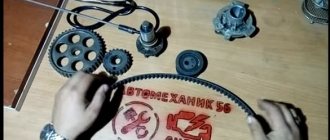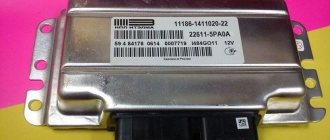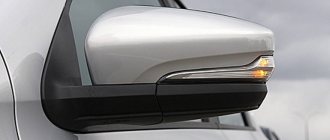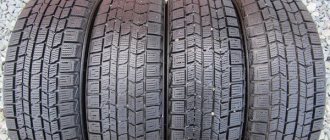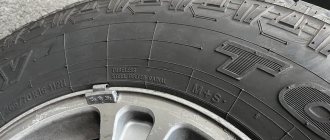Russian winters are always famous for long and severe frosts, which is why every driver is faced with the task of thermal insulation of his vehicle. This work is not difficult; with proper organization, you can do it yourself, without the help of specialists.
Insulation of the car interior
The most common problem when insulating the interior is drafts that appear after the rubber door seals are deformed. If you replace them with whole ones, then there will be a constant positive temperature in the cabin, provided that after replacement the gaps between all parts of the car body are uniform and not too large.
Covering the body with sound-proofing and heat-insulating materials (sound and heat insulation of the interior) will make the interior even warmer. It is worth noting that before starting this rather labor-intensive procedure, you need to choose the right insulating material. Almost all of these products perfectly absorb moisture that constantly appears in the car during rain, washing or in the form of evaporation. However, there is also a drawback: after some time, this “thermal insulation” will begin to rot, causing an unpleasant odor in the car. Therefore, you should purchase a product that will not only provide warmth to the interior, but will also not absorb water.
Thermal protection equipment for VAZ family cars
By insulating the inside of the car, we create conditions to reduce heat transfer from the body and maintain a constant temperature in the cabin. At the same time, it also has excellent sound insulation, which significantly reduces noise in the cabin. Having insulated it, we see how the car windows stop fogging up, and we feel more comfortable and safe.
Recommendations on how to properly install insulation on VAZ family cars:
- First of all, get rid of domestic rubber seals; the poor quality of their manufacture prevents heat retention and drafts circulate throughout the cabin. To do this, you need to identify leaks at the sink and insulate these places well, they are simply not airtight. Install a new set of seals;
- remove pads and carpets from the interior floor and install the selected insulation, preferably penofol. This three-millimeter material with foil retains heat well and provides good sound insulation;
- remove the ceiling covering, cut out the required pieces of foam foam and carefully glue it to the interior ceiling. Don’t forget to seal the niche and rear seat panel with insulation;
- on the doors, remove the trim and vapor barrier. From the insulation, prepare gaskets suitable for the configuration and secure them to the doors using tape. Do not forget to leave holes for handles and levers, reinstall the trim and check the free movement of the window lifters;
- disassemble the dashboard, dismantle the heater radiator and check all the seams on it, carefully seal them. This work will add an extra 5-6 degrees of heat to your cabin and in cold weather it will become more noticeable.
We insulate the interiors of other VAZ cars in a similar way. When driving a VAZ 2115, 2110 and Priora in winter, many passengers sitting in the back seat often pay attention to the flow of cold air in this part of the cabin. The fact is that in the rear door at the very bottom there are ventilation linings made of plastic. At speed, such ventilation significantly lowers the temperature inside the cabin.
To better insulate the interior, you need to significantly reduce the flow of cold air. To do this, we remove the plastic linings and exactly according to them, cut out the required size from the insulation with a small margin. We glue the material onto the front side of the lining with special glue. We coat the hole for the overlay with Movil and install the overlay covered with insulation in place. Now the cold no longer penetrates into the interior, and ventilation is maintained and prevents moisture and condensation from accumulating at the bottom of the door.
Insulation of the engine and hood of a car
Covering the engine with a felt blanket can result in a fire, so if your region does not have very severe winters, then you can get by with the usual thermal protection of the hood. And for those car owners who live in places with winter temperatures of more than -25 C°, we offer several of the safest options for car insulation .
Firstly, you should clarify why you should definitely insulate your car engine.
- Due to the long warm-up of the engine in winter, significant excess fuel consumption occurs, as well as faster wear of engine parts;
- a layer of ice that forms on the hood can damage the paintwork.
Many drivers know that starting a very cold engine leads to a negative impact on the service life of this most important part of the car. This occurs due to changes in some properties of motor oil and gasoline/diesel fuel at low temperatures. When the viscosity of the oil increases, for example, it cannot immediately penetrate into the necessary remote engine systems: when starting the engine with such oil, for a certain time it will experience a lack of oil lubrication in its parts, which, with constant friction, will cause rapid wear.
Also, engine starting in winter is affected by the fact that gasoline begins to evaporate worse - this leads to a deterioration in the preparation of the fuel-air mixture inside the car. And the battery at temperatures below zero does not release its full charge capacity.
To avoid all of the above problems, advanced technologies offer the use of several inventions that simplify the process of starting and operating a car in winter:
- pre-start engine heating: a device that warms up the engine before starting it. It saves not only time, your nerves and strength, but also fuel, and also prevents premature wear of engine parts and battery overload.
- Insulating the battery is simply a necessary measure in extreme cold, since the frozen mixture of distilled water and electrolyte should never be used until it is completely thawed, because when the starter is started, this frozen liquid will release explosive gas.
Having determined the main reasons why it is necessary to insulate not only the interior, but also the internal parts of the engine, you should choose the best option, suitable both in terms of convenience and financial capabilities.
Naturally, there are no ideal methods; they all have advantages and disadvantages.
For insulation, you will need a sheet of this material of the required size and clips to secure the insulation to the hood. In summer it is advisable to remove it.
The second option for engine insulation is a car blanket . This type of insulation can be made independently, having the necessary materials, or you can buy a ready-made version. To make your own, you will need: fiberglass and internal filler, or mullite-silica wool. These materials are used for insulation of oil and gas pipelines, as well as in fire-resistant shields. Their low thermal conductivity and completely non-flammable composition allows them to withstand temperatures up to 12,000 degrees, and also not be subject to chemical attack from various technical fluids.
Among the most modern technical “gadgets” for cars in terms of engine insulation, we can highlight:
- Electric heater;
- Autonomous pre-start heater.
Electric heating of a car engine is a very convenient means of maintaining the optimal temperature and preventing freezing of engine parts, but it has, rather than a drawback, but a feature - it requires a power source of two hundred and twenty volts near the place where the car is stored. The time required for heating from this device ranges from twenty to forty minutes and requires manual activation.
A preheater has more advantages than an electric heater, one of the main ones, for example, is the presence of the option to “turn on/off” this heater several times at night or during the day, as well as the autonomy of this device, which does not require the power to be constantly on.
At the moment, these methods are the most relevant and modern. Of course, the best and most reliable option would be a combination of all of the above methods. The question: “ What is the best way to insulate a car in winter ” will disappear by itself. However, when installing any thermal insulation, you should know several nuances:
- To prevent engine damage due to insulation parts getting on the pulleys of the pump, generator, fan drive or under the belts, all parts of the insulation material should be secured as securely as possible.
- Naturally, in winter the air temperature is almost always low, but there are days when it becomes +. At positive temperatures, the thermal insulation should be partially opened for a greater flow of cold air to prevent overheating of the engine. To do this, make special valves on the thermal insulation material installed on the radiator, which will close and open without completely removing the thermal insulation, and also have a reliable fixation both open and closed.
Many people are interested in how to insulate a car interior with their own hands. This work allows you to avoid many problems with operating the machine in winter. At a minimum, the comfort of the cabin will increase. In turn, this will improve the quality of management, which has a positive impact on safety. Yes, and it’s just nice to plop down from the cold into a warm cabin to go home. Warmth in a car is especially appreciated by people who travel quite long distances. To overcome a “shoulder” of 600 kilometers, sitting wrapped up to your ears in fur coats and padded jackets, compares to a feat. Therefore, do not spare money and time for complete insulation of the interior.
How to properly save fuel during the winter
Insulating a radiator using a piece of cardboard is an old method that is a myth. This method has been popular since the times of the Soviet Union. It remains relevant to this day. However, many people do not even realize that this approach is not useful, since it can cause you unnecessary problems. After installing the cardboard, the engine may overheat, boil and completely fail. Cardboard will not help you in this situation.
Before you insulate your car for the winter with your own hands, use a few tips for saving fuel in the winter:
- Try not to warm up the car engine. During winter, additional warming up of the engine leads to an increase in fuel consumption, and fuel costs can seriously increase. Do not leave your car outside overnight; be sure to drive it into the garage, then warming up will not be necessary (provided that your garage is insulated).
- Use special materials designed for this purpose. There is no need to show any initiative; there is no need to insulate the car with all available means. For this purpose, use only proven materials, because otherwise the saying will apply: “the miser pays twice.”
Material selection
How to insulate a car interior with your own hands? This is quite a complex job that will require a large number of different actions from you. Difficulties begin from the moment of selecting heat-insulating material. It should hold heat well and not emit any harmful substances. Still, you will spend a lot of time in the salon.
The following materials are most often used for work:
- Penofol
. This is the cheapest insulation. It retains heat perfectly and also does not allow noise to pass through. An additional advantage is the long service life; - Citizol and isotone
. These sheet materials are primarily sound insulators, but they also retain heat well; - Isoflex
is a good material. In high demand. The reason is low cost; - Polyurethane foam
. It is applied by spraying. Used for insulating cracks. Requires special equipment for application. In this regard, it is used quite rarely by garage craftsmen.
As you can see, there are quite a lot of materials to work with. Your task is to choose the most suitable option for you.
Tools
Installation of thermal insulation on UAZ cars
In the UAZ-469, in winter, another heater is installed or the standard one is replaced with a device of increased power. It all depends on the finances and taste of the car owner; we recommend the heater used on minibuses of the KITB.3221-8110010 brand.
If your UAZ is equipped with equipment for running on gas, then a gas autonomous heater is perfect, but its power must be at least 2-4 kW. The electronics of this device automatically maintains the temperature regime inside the cabin, but a specialist must connect the device.
The additional heater is located at the rear at the very end of the cabin.
Insulate the bottom of the cabin with warm linoleum or a set from the store designed specifically for the UAZ floor, consisting of foil foam rubber. Cover the interior ceiling, sides, door panels and the area under the dashboard with the same insulation. UAZ Hunter seals are suitable for all door openings.
Install a warm polymer top instead of a canvas one, and seal all holes and cracks in the interior.
When installing heat protection on a UAZ-3909 or, simply put, on a “loaf”, you must try not to seal the standard ventilation system, making the interior a kind of thermos. If you accidentally block the factory ventilation, a large mass of condensation will form in the cabin.
Polyurethane foam, coupled with polystyrene foam covered with foil, prevents heat from escaping from the interior and lasts quite a long time, so this coating is fully justified. Another option is to sheathe the interior with 4 mm plywood or cover it with medium-thick foam rubber.
It is also recommended to cover the floor in the loaf cabin with aluminum sheets. If additional heaters are placed under the seats on such a floor, the heat in the body will remain for a long time.
So for little money you can pretty well insulate the interior of a UAZ loaf with your own hands.
You can see how the interior of a UAZ loaf is insulated with polyurethane foam at this link:
Preparing the car
Before carrying out insulation work, the interior should be disassembled. All the seats are pulled out of it. It is imperative to dismantle the trim, this also includes the headliner. On some models it is quite difficult to pull it out, but if you leave the roof without insulation, then all other work will be pointless. Be sure to wash your car. This will allow the material to be laid more evenly. In addition, you should pay attention to the doors. They are also insulated. To do this you will have to remove the casing from them too. When removing controls for mirrors and lifts, be careful not to break them.
After removing the casing, carefully inspect the body. All excess and unnecessary holes are sealed. Particular care should be taken to evaluate the transition points of the wiring from the passenger compartment to the engine compartment. Install new seals. This will prevent heat leakage.
How to insulate a gasoline engine
If the vehicle is equipped with a gasoline power plant, insulating the engine for the winter is also a necessary component.
The radiator should be insulated according to the above method, but use special insulation materials rather than cardboard. When the temperature rises, their valves will open and prevent the engine from overheating. You can additionally lay an insulating layer between the radiator itself and its grille.
What can be installed under the hood:
- Mineral wool.
- Felt.
- Foil polypropylene.
There are other insulation materials on sale. From them you can cut blanks of the required size and make insulation.
To insulate the motor, you should proceed in the following sequence:
- Remove the power unit protection, clean from dirt and degrease.
- Cut a blank from a piece of insulation so that it overlaps the places where the protection is attached with a gap of 2 cm.
- Carefully press the insulation onto the surface of the protection.
- Cover the oil pan with insulation, having previously degreased it.
- For the most extreme points of the north, insulate the gap between the engine compartment and the car interior.
It will be quite difficult to do this, but the result will exceed all expectations.
Insulation of the interior
Having prepared the car for work, you can proceed directly to insulation. This is done in the following order:
- New door seals are being installed. This will minimize heat loss through door gaps. In general, they should be changed every 2 seasons. This is caused by the relatively rapid wear of these elements;
- Patterns of all elements planned for insulation are made. For this you will need prepared cardboard;
- It is better to treat the underbody of the car with anti-corrosion agent. This will reduce the risk of rust;
- Using a stationery knife, we cut out the necessary pieces of insulation according to the patterns. It is recommended to make elements with a margin of several centimeters. It’s better to trim off the excess afterwards;
- Insulation begins from the floor. Glue is applied to the material, after which it is placed on the floor of the cabin. Having leveled a piece of thermal insulation, it is lightly pressed and left to dry. Usually in warm weather, waiting a couple of hours is enough. After drying, lay the floor covering;
- Let's move on to the doors. This is one of the most difficult elements to insulate. Cut pieces of insulation are glued to the inside of the lining. After this, the door trim is reinstalled, as well as all the removed elements. Don’t forget to check the operation of locks and power windows; We glue the sides of the body. Here the principle of operation is practically no different from the process described above;
- The last thing to insulate is the ceiling. Even though it is smooth, one inconvenience will still await you. It is almost impossible to fix the insulation evenly alone. Therefore, this work should be done with an assistant. The glue is applied to the surface of the heat-insulating material. After which, the heat insulator is glued to the ceiling. It is recommended to hold it for a couple of minutes, waiting for the glue to initially set. After drying, check the reliability of fastening of the material and install the casing in place.
All that remains is to install it in place. By insulating the interior in this way, you can save some fuel in the winter. After all, you will turn on the stove much less often.
Conclusion
. Before the winter cold, many car enthusiasts strive to prepare their car for operation in subzero temperatures. Therefore, the question of how to insulate a car interior with your own hands is not uncommon. In practice, insulating a car is not a complicated process, but due to the large number of related operations, you will have to tinker a bit.
Our country, as you know, is famous for its severe frosts, as well as the length of the cold season. Accordingly, in order to survive severe frosts and save fuel, we have to thoroughly insulate ourselves. And we have considerable distances, which makes life even more difficult in winter. Therefore, it is also necessary to insulate the car interior. Russian-made cars are characterized by low quality noise insulation and thermal insulation. This is evidenced by numerous complaints from owners about the cold in the car even with a well-functioning stove; this problem especially worsens over time. The older the car, the more its thermal insulation deteriorates. The main reason is the low quality of parts assembly. Insufficiently tight and airtight connections of components and parts allow cold and noise to freely enter the car interior.
Insulation of the car interior
Foreign cars, despite their high build quality, can also succumb to the peculiarities of our climate. And buying a foreign car in itself does not guarantee good thermal insulation. While there may be no problems with the interior, the space under the hood with all its contents may suffer from low temperatures. Of course, the build quality and connection density here is significantly superior to products from the Russian automotive industry, but now the situation is changing. Therefore, our cars are more often insulated than foreign cars, or foreign cars with a fairly long service life.
How to insulate a diesel engine
A diesel engine is most vulnerable to low temperatures. Frost below 20 degrees is a critical point for him. So you should arm yourself with the necessary tools and materials and get down to business.
You will need:
- Regular office stapler;
- Scissors with sharp ends;
- Corrugated polyethylene;
- Tools for working with silicone.
Stages of work:
- Drive the vehicle into the inspection hole.
- Measure the circumference of the pipeline.
- Cut a strip of polyethylene foam to fit the pipe.
- Lay the insulation and secure with a stapler.
- Seal the tail at the end of the winding with sealant.
In the same way, caulk all the cracks under the hood. Please note that the corrugation for insulation should be at least 5 mm.
Next, proceed to the radiator:
- Measure the perimeter of the radiator.
- Cut a piece of insulation 2 times larger than the radiator itself to cover it on both sides.
- Push the workpiece, starting from the lock drive and gradually straightening it.
- Slide the insulation up under the lock.
If you use felt material rather than insulation, be sure to leave some space for air flow, otherwise overheating is possible.
There is no need to make any additional fastenings. There is no need to caulk the remaining cracks to prevent the possibility of engine overheating.
The engine itself should be covered with an old blanket or any felt material.
By turning the foil down, you can insulate the ramp and fuel filter. True, this is done in the most extreme frosts.
How to insulate a car
There are probably as many ways to insulate car interiors as there are car owners. This is especially true for owners of domestic cars, who, like no one else, show their creative and technical skills. The interior can be upholstered from the inside with thermal insulation material. Vibroplast, or isolon, or other materials are excellent for this. The use of these materials makes it possible to minimize extraneous noise in the car interior, and, most importantly, heat loss is significantly reduced. That is, in winter the upholstery protects against heat loss, and in summer, on the contrary, from cold, a kind of thermos effect is obtained.
As an alternative to upholstery, you can use the method of spraying a foaming composition. Foamed polyurethane is ideal for such a composition. True, its application will require expensive equipment. The polyurethane layer can be quite thin, since the material has excellent thermal insulation properties. In addition, it lays down in a high-quality monolithic layer and allows you to close all the cracks and holes through which cold air could penetrate inside the car. Another advantage of using polyurethane foam is the protection of metal from corrosion.
In the video - insulating a car door:
In addition to the internal upholstery, the external upholstery can also be replaced. For this purpose, vinyl artificial leather is used - a fairly economical material with good thermal insulation properties. This material is presented on the market in a large number of different colors, so you can indulge in any flight of fancy.
Do-it-yourself procedure for thermal insulation of an engine
- Remove the pattern from the inside of the hood. It is convenient to do this using tracing paper.
- We transfer the pattern to the material. Carefully cut out the parts with a stationery knife.
- Using moisture-resistant glue, we attach the thermal insulation to the inside of the hood, while the foil should remain outside.
You need to attach the insulation especially carefully so that it does not come off when driving, otherwise this will lead to unpleasant consequences for the engine and for you. Again, you need to manage to do this so that in the spring you can remove the insulation without damaging the hood.
Important. Automotive thermal insulation should not come into contact with the exhaust manifold and exhaust parts.
That's the whole trick! The costs for materials are minimal, but what is the result? The car warms up faster because heat does not escape through the hood. The engine remains warm for a long time, which means starting the car will be faster and easier. At the same time, car oil will not become viscous from the cold, and ice will no longer form on the hood, which can lead to metal corrosion.
The issue of car fuel economy is also being resolved. This also achieves the effect of engine noise insulation.
Recently, special car blankets for engine insulation have gone on sale. A very convenient thing. You just cover the engine in frosty weather, and when it gets warmer, remove it. It is only important to select this kind of thermal insulation according to the size of the engine compartment of your car. The main characteristics of a blanket for engine thermal insulation: fire resistance up to 800°C; fuel savings up to 30%.
In addition, insulate the car’s radiator grill with a so-called “muzzle.” It is very easy to sew using materials such as vinyl leatherette, batting or foam rubber. It is very easy to use. When they put it on coldly, it became warm, and they took it off.
